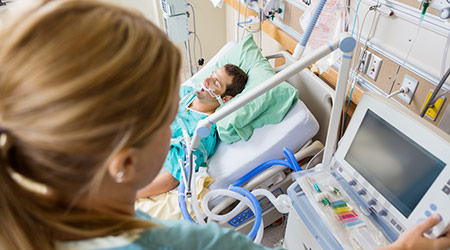Introduction
Moving around in a critical care environment can be challenging, regardless of whether you are a clinician, patient, or patient’s loved one. In addition to maneuvering around objects like medical equipment, staff must perform a variety of tasks for their patients – such as administering medications, maintaining constant surveillance of vital signs, and transporting patients to tests – all while performing an increasing amount of electronic medical record keeping.
Overview
My conversations with bedside clinicians, middle managers, and administrators point to an increasing push to bring the clinician to the bedside to spend more time with the patient, while improving clinical workflows. It makes sense, but how do we get there? That’s the challenging part. Let’s explore three key ways to improve workflow in your unit and give your clinicians more time at the bedside – which is probably why they chose a career in healthcare in the first place.
#1 Make information access easy
We’ve all seen nurses and physicians hovered over a computer, either “on wheels” in the hall, at the nurses’ station, or even in the patient’s room. They may be working on admission data, looking up lab values, using the Medication Administration Record (MAR), or charting patient assessments and interventions. The problem is that they often have to go to several places to perform these activities away from their patient.
What’s the solution? Using a single workstation in the patient’s room. Having one screen for information access can decrease equipment in the room and bring the clinician to the bedside. While being at the patient’s side, they can see real-time vital signs with waveforms and other monitoring information, including alarms. They can access the Hospital Information System (HIS) for admission demographic data via a wireless bar code scanner, which they can also use for quickly admitting a patient to the monitor, and administering medication – all while charting at the bedside.
If you choose to implement this workflow-saving solution, spend time planning the best ergonomic placement of the workstation.
Ask yourself these questions:
• Can the mounting height be easily adjusted for taller and shorter clinicians?
• Is there a place for that medication the nurse is about to give?
• How can you best position the workstation so it puts the clinician face-to-face with the patient?
• Does it interface with essential equipment – such as the ventilator?
Creating a full-size replica to serve as a working example of the layout of the room can be eye opening. So bring all the equipment you would use for your sickest patient into an empty ICU room. Move everything around and try out different placements for workflow improvement. Maybe there’s a better way than how you’ve always done it. While you are at it, invite all clinicians to give their input. Not only can it give you a fresh perspective, but it also gains buy-in to your new design.
#2 Streamline patient transport
Any nurse who has accompanied a patient to a test or procedure outside of the critical care unit understands how stressful, time consuming, and risky patient transport can be.
What’s the solution for streamlining patient transport? A compact monitor that can also be used at the bedside and easily removed and placed with the patient for transport can save valuable time. By using the same monitor for both bedside and transport, you can eliminate time spent looking for a separate transport monitor, disconnecting and reconnecting your patient, and untangling cables in the exchange.
Having the ability to monitor a patient’s vital signs while on transport is essential. Obviously, you need to monitor basic parameters such as ECG, blood pressure, and oxygen saturation. But you also may need to monitor advanced parameters such as invasive pressures.
If you are purchasing new monitors, consider the maximum number of parameters that you can use on transport. Also consider the screen size, weight, and ease of switching the monitor from bedside to transport and back again. Be sure to choose a system with a docking station that constantly charges the monitor so it has a full battery for transport on demand.
Another significant workflow improvement is to make sure the transport monitor is Wi-Fi enabled. This will allow an easy and continuous flow of data to the EMR – without having to re-admit the patient. Finally, select a monitor that protects critical patient data from unauthorized access.
When examining your transport workflow, ask these questions:
• Are we monitoring all the values we need to on transport – including everything we are monitoring at bedside?
• Is the monitor safely mounted during transport?
• Is there sufficient battery life to complete the transport?
• Is staff trained to use the monitoring device properly?
Examining your patient transport workflow and implementing improvements can increase patient safety and give more time back to your clinicians to spend with their patients.
#3 Get alarms under control
Alarm fatigue and management are pervasive problems in hospitals of all sizes. In addition, the Joint Commission’s National Patient Safety Goal #6 may still have some hospitals scrambling to meet alarm management goals.
Constant alarming desensitizes clinicians to alarms and may cause them to miss life-saving alarms. In addition, patients and visitors become overwhelmed by the noise and constant beeping of medical equipment – making for a less than peaceful environment.
Some critical care units do not have a designated ‘monitor watcher,’ so the burden of responding to alarms falls on the nurses – who are busy caring for patients, charting, administering medications, and performing other critical tasks.
What can you do? Educate your staff and management on the subject of alarm management. Many research studies and evidence-based practice articles exist about combating alarm fatigue. Explore general articles about alarm management, focusing on units that are similar to yours in type, size and structure.
Tackling alarm fatigue can be a monumental task. Start by forming a multidisciplinary group and focus on combatting ‘low-hanging fruit’ – that is, common things that are easier to fix. Research shows that up to 86%-99% of alarms are ‘false or clinically insignificant.’ By decreasing these alarms, you can free up clinicians for patient care, while maintaining a safe environment.
‘Low-hanging fruit’ to tackle might include ensuring proper patient skin preparation and electrode replacement, and adjusting policies regarding customization of alarm limits.
One of the biggest culprits of excessive alarms in critical care units is oxygen saturation monitoring. Work with your monitor manufacturer to make sure that you are optimizing the use of this and other parameters.
Educating your staff on the proper use of all alarming devices in the unit is essential, so be sure to budget an adequate amount for proper training. It’s an investment that will pay off.
When addressing alarm management, questions to ask include:
• Is there a constant hum of alarms in your unit?
• Do you see clinicians ignoring alarms?
• Are clinicians using unsafe workarounds to decrease alarms?
• Is your staff properly trained in recognizing alarms and managing them on the devices?
• Does everyone know whose responsibility it is to respond to an alarm?
Finally, but certainly not least important, take a hard look at how you can improve the culture of managing alarms in your unit. This can, perhaps, be the most challenging aspect of alarm management. Establishing a culture of active and proper alarm management will benefit your unit for years to come.
Conclusion
In conclusion, by taking the time to (1) make clinical information easier to access, (2) streamline patient transport, and (3) get alarms under control through a sound alarm management process, you can significantly improve the workflow in your critical care unit – regardless of its size.
Resources
https://www.ncbi.nlm.nih.gov/pmc/articles/PMC3037121/
https://www.ncbi.nlm.nih.gov/pubmed/21937236
https://www.ncbi.nlm.nih.gov/pmc/articles/PMC4705572/
https://www.ncbi.nlm.nih.gov/pubmed/24153215
https://www.aacn.org/clinical-resources/practice-alerts/alarm-management
http://www.jhconline.com/making-alarms-count.html
Susan Bushman, RN, BSN, Dräger has extensive critical care nursing experience and has consulted with numerous hospitals to help them improve their workflow and meet alarm management goals.

 Building Disaster Resilience Through Collaboration
Building Disaster Resilience Through Collaboration Amae Health Expands to New York City
Amae Health Expands to New York City Hospital for Special Surgery Opens Two New Facilities in New Jersey
Hospital for Special Surgery Opens Two New Facilities in New Jersey Should We Be Testing Toilet Water in Patient Restrooms?
Should We Be Testing Toilet Water in Patient Restrooms? Healthcare Union Petitions for Increased Staff Safety at HCA Florida Hospitals
Healthcare Union Petitions for Increased Staff Safety at HCA Florida Hospitals